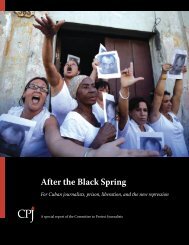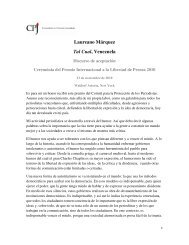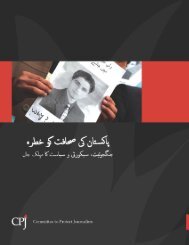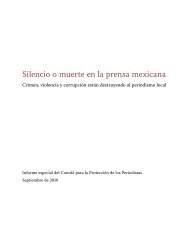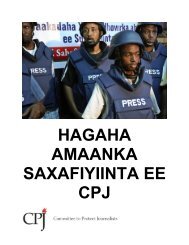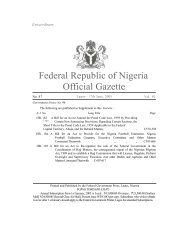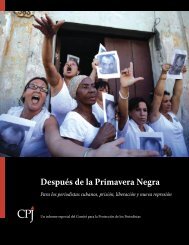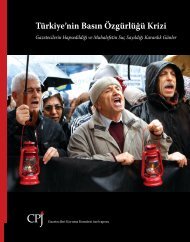Attacks on the Press - Committee to Protect Journalists
Attacks on the Press - Committee to Protect Journalists
Attacks on the Press - Committee to Protect Journalists
- No tags were found...
Create successful ePaper yourself
Turn your PDF publications into a flip-book with our unique Google optimized e-Paper software.
attacks <strong>on</strong> <strong>the</strong> press in 2009americas: nicaraguaWidespread corrupti<strong>on</strong> has rendered <strong>the</strong> criminal justice system so dysfuncti<strong>on</strong>althat most journalist killings remain unsolved. In <strong>the</strong> few cases where authoritieshave obtained c<strong>on</strong>victi<strong>on</strong>s, CPJ research shows, questi<strong>on</strong>s have emergedabout <strong>the</strong> culpability of <strong>the</strong> accused. One such case, <strong>the</strong> 2007 murder of AmadoRamírez Dillanes, Acapulco corresp<strong>on</strong>dent for Televisa, was officially closed inMarch when a defendant was sentenced <strong>to</strong> 38 years in pris<strong>on</strong>. But in Acapulco,where Ramírez was a star journalist, colleagues said authorities had allowed <strong>the</strong>real murderers <strong>to</strong> go free. The Nati<strong>on</strong>al Human Rights Commissi<strong>on</strong> later foundthat police had <strong>to</strong>rtured <strong>the</strong> defendant and manipulated evidence.CPJ research shows that local and state authorities in Mexico have been particularlyineffective in solving press-related crimes—and, in some instances, appear<strong>to</strong> have been complicit. In a 2008 report, CPJ examined <strong>the</strong> possible involvemen<strong>to</strong>f local police and public officials in <strong>the</strong> disappearances of several journalistssince 2005. At least five missing reporters had investigated links between localofficials and organized crime in <strong>the</strong> weeks before <strong>the</strong>y vanished.C<strong>on</strong>gress moved in fits and starts <strong>to</strong> combat crimes against <strong>the</strong> press. TheChamber of Deputies approved a measure in April imposing special penalties forcrimes against “journalistic activity.” The bill would impose penalties of up <strong>to</strong> fiveyears in pris<strong>on</strong> for any<strong>on</strong>e who “impedes, interferes, limits, or attacks journalisticactivity.” Sentences could be doubled if <strong>the</strong> assailant were a public official. Themeasure was pending in <strong>the</strong> Senate in late year.The legislati<strong>on</strong>, if passed, would be an encouraging but preliminary step incombating deadly violence against <strong>the</strong> press, a CPJ analysis found. The enactmen<strong>to</strong>f new penalties, CPJ found, would have a significant effect <strong>on</strong>ly if accompaniedby adopti<strong>on</strong> of a c<strong>on</strong>stituti<strong>on</strong>al amendment granting federal authorities <strong>the</strong> jurisdicti<strong>on</strong><strong>to</strong> prosecute all crimes against free expressi<strong>on</strong>. The proposed amendmentwas still before <strong>the</strong> Chamber of Deputies in late year. In a setback for press freedom,<strong>the</strong> Chamber of Deputies decided <strong>to</strong> disband a special committee examiningviolence against <strong>the</strong> press. The committee, created in 2006, had helped keepanti-press violence in <strong>the</strong> public eye.Reporters and pho<strong>to</strong>graphers in several states <strong>to</strong>ld CPJ about threats, beatings,and arbitrary detenti<strong>on</strong>s at <strong>the</strong> hands of local police officers and soldiers.While some filed complaints with state and federal authorities, o<strong>the</strong>rs <strong>to</strong>ld CPJ<strong>the</strong>y were <strong>to</strong>o afraid <strong>to</strong> file official reports. In at least <strong>on</strong>e case, a provincial reporter,who asked not <strong>to</strong> be identified for fear of reprisal, <strong>to</strong>ld CPJ he had receiveda death threat from a high-ranking police official.Emilio Gutiérrez So<strong>to</strong>, a Chihuahua journalist who fled <strong>to</strong> <strong>the</strong> United Statesafter facing harassment, was awaiting a decisi<strong>on</strong> in late year <strong>on</strong> his applicati<strong>on</strong>for political asylum. Gutiérrez So<strong>to</strong>, a corresp<strong>on</strong>dent for El Diario del Noroeste inNuevo Casas Grandes, fled Chihuahua in 2008 after being threatened by militarypers<strong>on</strong>nel in resp<strong>on</strong>se <strong>to</strong> articles alleging human rights abuses.CPJ documented four instances in which buildings housing news organizati<strong>on</strong>sor <strong>the</strong>ir employees were attacked. In January, gunmen hurled a grenade andshot at <strong>the</strong> premises of nati<strong>on</strong>al broadcaster Televisa in M<strong>on</strong>terrey. (A spokesmanfor Televisa later <strong>to</strong>ld CPJ that its crime reporters had been using bulletproof vestsfor more than a year.) The next m<strong>on</strong>th, assailants shot at <strong>the</strong> home of <strong>the</strong> edi<strong>to</strong>r ofEl Debate, a daily newspaper in Guasave, in <strong>the</strong> state of Sinaloa. The weekly Ríodoce,which covers drug trafficking in Sinaloa, was hit by an explosi<strong>on</strong> in Septemberthat caused structural damage. In each case, senior edi<strong>to</strong>rs said <strong>the</strong>y weren’t surewhy <strong>the</strong>y had been targeted. No arrests were made in any of <strong>the</strong> cases.In August, <strong>the</strong> federal government released a c<strong>on</strong>troversial report in<strong>to</strong> <strong>the</strong>killing of Bradley Will, a U.S. documentary filmmaker. Will was shot in November2006 while filming clashes in Oaxaca between antigovernment protesters andsupporters of Gov. Ulises Ruiz. Despite pho<strong>to</strong>graphic evidence that pro-governmentgunmen were shooting from a distance at dem<strong>on</strong>stra<strong>to</strong>rs and journalists—including Will—authorities c<strong>on</strong>cluded that <strong>the</strong> fatal shots had instead been firedby a protester at close range. In Oc<strong>to</strong>ber 2008, a Mexican judge ruled that <strong>the</strong>rewas enough evidence <strong>to</strong> bring Juan Manuel Martínez <strong>to</strong> trial for Will’s killing.Martínez remained in jail in late year. No witness has placed Martínez at <strong>the</strong>scene, no motive has been disclosed, and no weap<strong>on</strong> has been produced.The government’s report <strong>on</strong> <strong>the</strong> Will case c<strong>on</strong>tradicted findings by <strong>the</strong> Nati<strong>on</strong>alHuman Rights Commissi<strong>on</strong> and Physicians for Human Rights, a Bost<strong>on</strong>basedindependent organizati<strong>on</strong>, both of which c<strong>on</strong>cluded that <strong>the</strong> two bullets thatstruck Will had been fired from a distance of 130 <strong>to</strong> 165 feet (40 <strong>to</strong> 50 meters). Thegovernment report also c<strong>on</strong>tradicted <strong>the</strong> au<strong>to</strong>psy, which found that <strong>the</strong> wounds <strong>to</strong>Will’s body and damage <strong>to</strong> his clothing were c<strong>on</strong>sistent with l<strong>on</strong>g-range shots.NICARAGUAThree decades after a revoluti<strong>on</strong> swept <strong>the</strong> sandinistas in<strong>to</strong> power,<strong>the</strong> government of President Daniel Ortega still cast private media as enemiesand moved forcefully <strong>to</strong> curtail <strong>the</strong>ir influence. Ortega—who led <strong>the</strong> 1979 uprisingagainst <strong>the</strong> Somoza dicta<strong>to</strong>rship and reclaimed <strong>the</strong> presidency in 2006electi<strong>on</strong>s—employed a range of tactics <strong>to</strong> marginalize <strong>the</strong> press, including legalpersecuti<strong>on</strong>, smear campaigns <strong>to</strong> discredit adversaries, and manipulati<strong>on</strong> of stateadvertising <strong>to</strong> punish critical outlets.The administrati<strong>on</strong> ignored private media outlets and disparaged <strong>the</strong>ir work.Local reporters had no access <strong>to</strong> Ortega or his close advisers, and were often excludedfrom government events. Ortega himself remained an elusive figure: His agenda9 09 1




